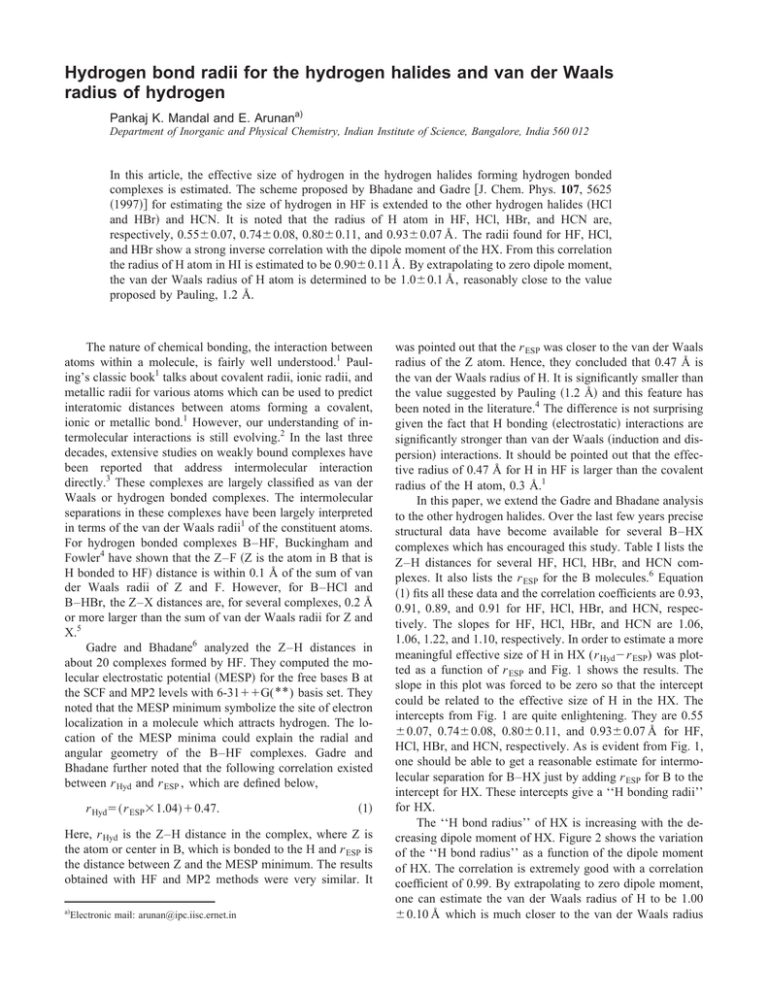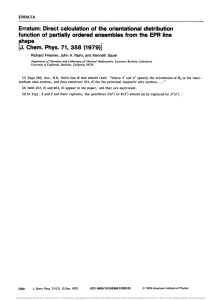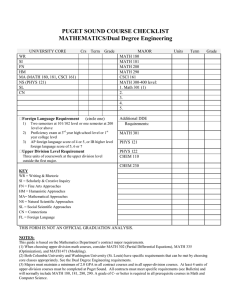Hydrogen bond radii for the hydrogen halides and van der... radius of hydrogen Pankaj K. Mandal and E. Arunan
advertisement

Hydrogen bond radii for the hydrogen halides and van der Waals radius of hydrogen Pankaj K. Mandal and E. Arunana) Department of Inorganic and Physical Chemistry, Indian Institute of Science, Bangalore, India 560 012 In this article, the effective size of hydrogen in the hydrogen halides forming hydrogen bonded complexes is estimated. The scheme proposed by Bhadane and Gadre 关J. Chem. Phys. 107, 5625 共1997兲兴 for estimating the size of hydrogen in HF is extended to the other hydrogen halides 共HCl and HBr兲 and HCN. It is noted that the radius of H atom in HF, HCl, HBr, and HCN are, respectively, 0.55⫾0.07, 0.74⫾0.08, 0.80⫾0.11, and 0.93⫾0.07 Å. The radii found for HF, HCl, and HBr show a strong inverse correlation with the dipole moment of the HX. From this correlation the radius of H atom in HI is estimated to be 0.90⫾0.11 Å. By extrapolating to zero dipole moment, the van der Waals radius of H atom is determined to be 1.0⫾0.1 Å, reasonably close to the value proposed by Pauling, 1.2 Å. The nature of chemical bonding, the interaction between atoms within a molecule, is fairly well understood.1 Pauling’s classic book1 talks about covalent radii, ionic radii, and metallic radii for various atoms which can be used to predict interatomic distances between atoms forming a covalent, ionic or metallic bond.1 However, our understanding of intermolecular interactions is still evolving.2 In the last three decades, extensive studies on weakly bound complexes have been reported that address intermolecular interaction directly.3 These complexes are largely classified as van der Waals or hydrogen bonded complexes. The intermolecular separations in these complexes have been largely interpreted in terms of the van der Waals radii1 of the constituent atoms. For hydrogen bonded complexes B–HF, Buckingham and Fowler4 have shown that the Z–F 共Z is the atom in B that is H bonded to HF兲 distance is within 0.1 Å of the sum of van der Waals radii of Z and F. However, for B–HCl and B–HBr, the Z–X distances are, for several complexes, 0.2 Å or more larger than the sum of van der Waals radii for Z and X.5 Gadre and Bhadane6 analyzed the Z–H distances in about 20 complexes formed by HF. They computed the molecular electrostatic potential 共MESP兲 for the free bases B at the SCF and MP2 levels with 6-31⫹⫹G( ** ) basis set. They noted that the MESP minimum symbolize the site of electron localization in a molecule which attracts hydrogen. The location of the MESP minima could explain the radial and angular geometry of the B–HF complexes. Gadre and Bhadane further noted that the following correlation existed between r Hyd and r ESP , which are defined below, r Hyd⫽ 共 r ESP⫻1.04兲 ⫹0.47. 共1兲 Here, r Hyd is the Z–H distance in the complex, where Z is the atom or center in B, which is bonded to the H and r ESP is the distance between Z and the MESP minimum. The results obtained with HF and MP2 methods were very similar. It a兲 Electronic mail: arunan@ipc.iisc.ernet.in was pointed out that the r ESP was closer to the van der Waals radius of the Z atom. Hence, they concluded that 0.47 Å is the van der Waals radius of H. It is significantly smaller than the value suggested by Pauling 共1.2 Å兲 and this feature has been noted in the literature.4 The difference is not surprising given the fact that H bonding 共electrostatic兲 interactions are significantly stronger than van der Waals 共induction and dispersion兲 interactions. It should be pointed out that the effective radius of 0.47 Å for H in HF is larger than the covalent radius of the H atom, 0.3 Å.1 In this paper, we extend the Gadre and Bhadane analysis to the other hydrogen halides. Over the last few years precise structural data have become available for several B–HX complexes which has encouraged this study. Table I lists the Z–H distances for several HF, HCl, HBr, and HCN complexes. It also lists the r ESP for the B molecules.6 Equation 共1兲 fits all these data and the correlation coefficients are 0.93, 0.91, 0.89, and 0.91 for HF, HCl, HBr, and HCN, respectively. The slopes for HF, HCl, HBr, and HCN are 1.06, 1.06, 1.22, and 1.10, respectively. In order to estimate a more meaningful effective size of H in HX (r Hyd⫺r ESP) was plotted as a function of r ESP and Fig. 1 shows the results. The slope in this plot was forced to be zero so that the intercept could be related to the effective size of H in the HX. The intercepts from Fig. 1 are quite enlightening. They are 0.55 ⫾0.07, 0.74⫾0.08, 0.80⫾0.11, and 0.93⫾0.07 Å for HF, HCl, HBr, and HCN, respectively. As is evident from Fig. 1, one should be able to get a reasonable estimate for intermolecular separation for B–HX just by adding r ESP for B to the intercept for HX. These intercepts give a ‘‘H bonding radii’’ for HX. The ‘‘H bond radius’’ of HX is increasing with the decreasing dipole moment of HX. Figure 2 shows the variation of the ‘‘H bond radius’’ as a function of the dipole moment of HX. The correlation is extremely good with a correlation coefficient of 0.99. By extrapolating to zero dipole moment, one can estimate the van der Waals radius of H to be 1.00 ⫾0.10 Å which is much closer to the van der Waals radius TABLE I. The r ESP values of the bases 共B兲 and the H-bond distances (r HYD) for the H-bonded complexes B–HX. All the distances are in Å. r HYD of B–HX B r ESPa X⫽F X⫽Cl HF H2O HCN H3N OC C2H2 C2H4 H2S CH3CN C3H6 SO2 C6H6 B2H6 CO2 N2O H2CO N2 1.27 1.27 1.36 1.25 1.54 1.60 1.62 1.79 1.34 1.52 1.32 1.93 2.08 1.46 1.40 1.26 1.57 1.86b 1.74c 1.87a 1.78a 2.12a 2.20a 2.22a 2.32a 1.83a 2.10a 1.89a 2.65a 2.50a 1.91a 1.94a 1.73a 2.16a 2.08d 1.93d 2.13d 1.85d 2.41d 2.42d 2.44d 2.53d 2.01e 2.28d 2.10d 2.71d 2.69f 2.15g 2.08h 1.97d 2.42i a n b o Reference 6. Reference 7. c Reference 8. d Reference 5. e Reference 9. f Reference 10. g Reference 11. h Reference 12. i Reference 13. j Reference 14. k Reference 15. l Reference 16. m Reference 17. X⫽Br X⫽CN 1.99j 2.19d 1.83d 2.49d 2.08m 2.24n 2.16o 2.61p 2.59q 2.64r 2.75s 2.21t 2.41u 2.49d 2.57d 2.07e 2.72k 2.79v 2.35w 2.52l 2.21x 2.55y Reference 18. Reference 19. p Reference 20. q Reference 21. r Reference 22. s Reference 23. t Reference 24. u Reference 25. v Reference 26. w Reference 27. x Reference 28. y Reference 29. estimated by Pauling 共1.2 Å兲. As this corresponds to the situation of zero dipole moment, it will be a more realistic estimate of the van der Waals radius of the H atom. Figure 2 predicts that for HI complexes 共based on the dipole moment of 0.44 D兲 共Ref. 30兲 the Z–H distance should be r ESP⫹(0.90⫾0.11) Å. This prediction is validated by the FIG. 1. Plot of (r HYD⫺r ESP) vs r ESP for B–HX complexes. A constant 共C兲 has been added to the Y values of the four complexes for clarity; C HF⫽0, C HCl⫽1, C HBr⫽2, and C HCN⫽3. The line through the points show the best fit assuming the slope to be zero. The intercepts are shown in parentheses. FIG. 2. Plot of the effective size of H in HX (r eff) vs dipole moment 共Ref. 30兲 of H–X. The fit includes only HF, HCl, and HBr. For HCN, the C–H bond moment 共Ref. 4兲 is shown and it does not fit in the line. For HI, the predicted value for r eff is shown as an open circle. limited experimental data available on HI complexes. The distances observed are 0.86, 0.93, and 1.11 Å for the H2O, 31 HCN,32 and OC 共Ref. 33兲 complexes with HI. For the B–H2 complexes, the r Hyd should be closer to (1.01⫾0.10) ⫹r ESP Å. Structural data on H2 and HI complexes are still scarce and we hope this paper will stimulate efforts to study these complexes. The authors thank the Department of Science and Technology, India and the Director, Indian Institute of Science for partial support and Professors A. G. Samuelson and S. R. Gadre for stimulating discussions. L. Pauling, The Nature of the Chemical Bond 共Cornell University Press, Ithaca, 1960兲. 2 K. Müller-Dethlefs and P. Hobza, Chem. Rev. 100, 143 共2000兲. 3 van der Waals molecules-II, Special issue Chem. Rev. 94 共1994兲. 4 A. D. Buckingham and P. W. Fowler, Can. J. Chem. 63, 2018 共1985兲. 5 A. C. Legon, Angew. Chem. Int. Ed. Engl. 38, 2686 共1999兲, and references therein. 6 S. R. Gadre and P. K. Bhadane, J. Chem. Phys. 107, 5625 共1997兲, and references therein. 7 T. R. Dyke, B. J. Howard, and W. Klemperer, J. Chem. Phys. 56, 2442 共1972兲. 8 J. W. Bevan, Z. Kisiel, A. C. Legon, D. J. Millen, and S. C. Rogers, Proc. R. Soc. London, Ser. A 372, 441 共1980兲. 9 A. C. Legon, D. J. Millen, and H. M. North, J. Phys. Chem. 91, 5210 共1987兲. 10 C. Chuang, T. D. Klots, R. S. Ruoff, T. Emilsson, and H. S. Gutowsky, J. Chem. Phys. 95, 1552 共1991兲. 11 S. W. Sharpe, Y. P. Zeng, C. Wittig, and R. A. Beaudet, J. Chem. Phys. 92, 943 共1990兲. 12 Y. P. Zeng, S. W. Sharpe, D. Reifschneider, C. Wittig, and R. A. Beaudet, J. Chem. Phys. 93, 183 共1990兲. 13 R. S. Altman, M. D. Marshall, and W. Klemperer, J. Chem. Phys. 79, 57 共1983兲. 14 A. C. Legon and A. P. Suckley, Chem. Phys. Lett. 150, 153 共1988兲. 15 S. A. Cooke, G. K. Corlett, C. M. Evans, and A. C. Legon, Chem. Phys. Lett. 272, 61 共1997兲. 16 N. W. Howard and A. C. Legon, J. Chem. Phys. 90, 672 共1989兲. 17 A. J. Fillery, A. C. Legon, and L. C. Willoughby, Chem. Phys. Lett. 98, 369 共1983兲. 18 K. Georgiou, A. C. Legon, D. J. Millen, and P. J. Mjoberg, Proc. R. Soc. London, Ser. A 399, 377 共1985兲. 1 19 G. T. Fraser, K. R. Leopold, D. D. Nelson, A. Tung, and W. Klemperer, J. Chem. Phys. 80, 3073 共1984兲. 20 E. J. Goodwin and A. C. Legon, Chem. Phys. 87, 81 共1984兲. 21 P. D. Aldrich, S. G. Kukolich, and E. J. Campbell, J. Chem. Phys. 78, 3521 共1983兲. 22 S. G. Kukolich, W. G. Read, and P. D. Aldrich, J. Chem. Phys. 78, 3552 共1983兲. 23 E. J. Goodwin and A. C. Legon, J. Chem. Soc., Faraday Trans. 2 80, 1669 共1984兲. 24 N. W. Howard and A. C. Legon, J. Chem. Soc., Faraday Trans. 2 83, 991 共1987兲. 25 S. G. Kukolich, J. Chem. Phys. 78, 4832 共1983兲. 26 H. S. Gutowsky, E. Arunan, T. Emilsson, S. L. Tschopp, and C. E. Dykstra, J. Chem. Phys. 103, 3917 共1995兲. 27 T. D. Klots, R. S. Ruoff, and H. S. Gutowsky, J. Chem. Phys. 90, 4216 共1989兲. 28 E. J. Goodwin and A. C. Legon, J. Chem. Phys. 87, 2426 共1987兲. 29 E. J. Goodwin and A. C. Legon, J. Chem. Phys. 82, 4434 共1985兲. 30 Handbook of Chemistry and Physics, 80th ed. 共CRC Press, Boca Raton, 1999–2000兲. 31 A. McIntosh, T. Walther, R. R. Lucchese, J. W. Bevan, R. D. Suenram, and A. C. Legon, Chem. Phys. Lett. 314, 57 共1999兲. 32 P. W. Fowler and A. C. Legon, Chem. Phys. Lett. 226, 501 共1994兲. 33 Z. Wang, R. R. Lucchese, J. W. Bevan, A. P. Suckley, C. A. Rego, and A. C. Legon, J. Chem. Phys. 98, 1761 共1993兲.


